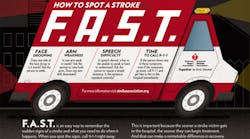“Body language: Without saying a word, it can say so much ... like someone is having a stroke. Know the sudden signs.” So begins a new public service announcement that encourages Americans to recognize the signs of stroke by using the acronym F.A.S.T. – face drooping, arm weakness, speech difficulty and time to call 9-1-1.
According to the American Stroke Association (ASA), stroke, which occurs when a blood vessel that carries oxygen and nutrients to the brain is either blocked by a clot or bursts, is the No. 4 cause of death and a leading cause of disability in the United States. A stroke occurs in the United States every 40 seconds, but Ad Council research shows that 28 percent of Americans would not recognize the signs.
ASA and the American Heart Association (AHA) have joined with the Ad Council to launch their first national, multimedia public service campaign to raise awareness about F.A.S.T., an acronym for recognizing and responding to the sudden warning signs of stroke. F.A.S.T. stands for:
Face Drooping – Does one side of the face droop or is it numb? Ask the person to smile to see.
Arm Weakness – Is one arm weak or numb? Ask the person to raise both arms. Does one arm drift downward?
Speech Difficulty – Is speech slurred? Is he or she unable to speak or hard to understand? Ask the person to repeat a simple sentence, like "the sky is blue." Is the sentence repeated correctly?
Time to call 9-1-1 – If the person shows any of these symptoms, even if the symptoms go away, call 9-1-1 and get him or her to the hospital immediately.
When it comes to stroke, time is critical. F.A.S.T. can help people to spot a stroke quickly, so that they can get medical help as soon as possible. Time is critical when a stroke occurs, so getting to the hospital quickly could help reduce disability and death from stroke.
“We are all fluent in body language,” said Rob Baiocco, executive vice president, executive creative director of Grey New York. “We speak it all day, every day. We want to add the language of stroke to everyone's vocabulary, so they can spot one fast, and help save a life.”
View the campaign's F.A.S.T. infographic and the public service video announcements online. For additional information, visit http://www.strokeassociation.org/STROKEORG.
